How to sow the lawn?
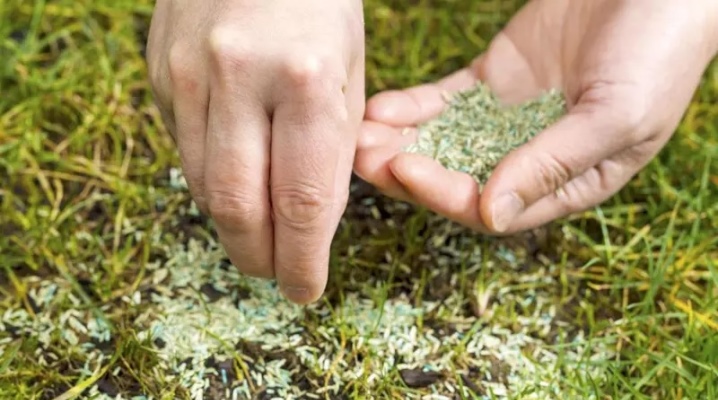
After the spring melting of snow, areas with dry grass and empty places - bald spots often remain on the lawn. In this case, the main space is covered with fresh green growth. The lawn should, of course, be restored to its well-groomed appearance. A beautiful lawn should have a uniform texture, a green, flat surface with no gaps that will quickly begin to fill up weeds. In this article, we will look at how you can get rid of gaps and yellow spots on an emerald lawn carpet.

Causes of the appearance of bald spots
All garden plants need some care after winter, lawn grass also requires additional care. The lawn is cleaned of litter, dead stems, loosened, watered, but often empty or thinned places remain on a beautiful green lawn.
A plot can lose its decorative appearance for various reasons:
- freezing in winter;
- rotting from rain or excess melt water;
- overgrowth of cereal grasses;
- oversupply of fertilizers or insufficient feeding;
- fungus or infection;
- pests: insects or rodents.
Most often, the presentable appearance is lost with improper care, and even small flaws on the old lawn will become even more noticeable. To eliminate bald spots, it is important to find out the reasons why certain defects have appeared. After a cold winter with a little snow cover, plants can simply freeze. To protect against frost, it is recommended to cover the lawn with foil or mulch.
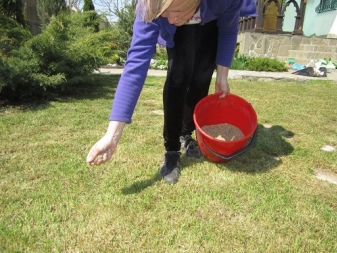
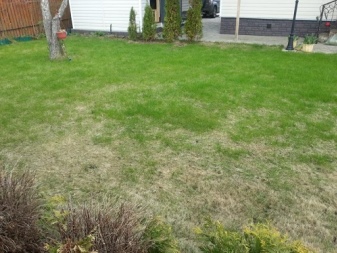
Consider the signs of damage.
- Brown or yellow leaves. Creeping stems indicate low moisture levels. It is recommended to water the lawn at least 1 time a week: in the morning (before the sun rises high) or in the evening. The water on the grass under the hot rays burns the leaves. Favorable time: early morning and from 16 to 18 hours. In hot summer, watering is carried out daily.
- Roots, stems rot, leaves turn yellow. In spring and in rainy summers, the land is often waterlogged. It is necessary to level the surface so that there is no stagnation of water in the lowlands. It is necessary to prevent soil caking (loosen, pierce with a pitchfork 15-17 cm to saturate with air) and equip a drainage system. Decay from excess water can be confused with a disease - black leg.
- Green-yellow grass and underdeveloped stems indicate a lack of nitrogenous fertilizers, and bald spots - phosphorus. Excess fertilizer also causes stains. It is necessary to strictly follow the instructions for use of a particular mineral mixture.
- Pits with embankments and burrows - moles or mice have settled on the site. It is necessary to get rid of pests: traps, ultrasound, poison or cat-mice will help.
- Plants can turn yellow and dry due to an excess of nitrogen, and the reason can also be pets who celebrate their needs on the territory. Good watering will help clean your lawn. A steel mesh dug in to a depth of 1.5 m along the edge of the private land will protect against unwanted intruders, including moles.
- White bloom on greenery, darkening and drying occurs with powdery mildew. The lawn is treated with a fungicide, dead parts are removed.
- Pink color, drying - red threadiness. The disease manifests itself from a lack of fertilizers. You need potassium fertilization and regular loosening.
- The appearance of dry circles on the green surface indicates an infection of the site with lichen or moss. This happens on moist acidic soils. Dead roots and stems are removed, dolomite and sand are introduced into the soil, and aeration is carried out.
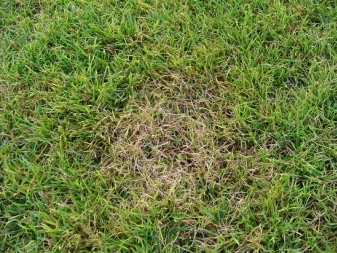
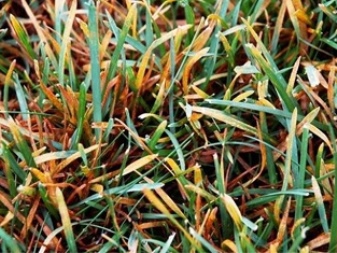
Step-by-step seeding instructions
When the causes of the damage have been determined, restoration work is carried out. They start by mowing the grass over the entire area. It is important to mow the lawn correctly: if the mower cuts the stems very close to the roots, the plants will begin to die. Timely watering and mowing can restore a dry cover without additional procedures.
With rotting roots, infectious and fungal diseases, the appearance of moss and lichen, the roots and stems are removed along with the top layer of the soil, and then they are treated with special preparations.
You can update the old lawn and give it a well-groomed look at any time of the year. Early spring and late autumn can negatively affect seed germination - at this time, you should beware of frost. It is not recommended to sow seeds on an already growing lawn in the summer: heat and dry air will delay the development of seedlings.
For overseeding, preliminary preparation is required.
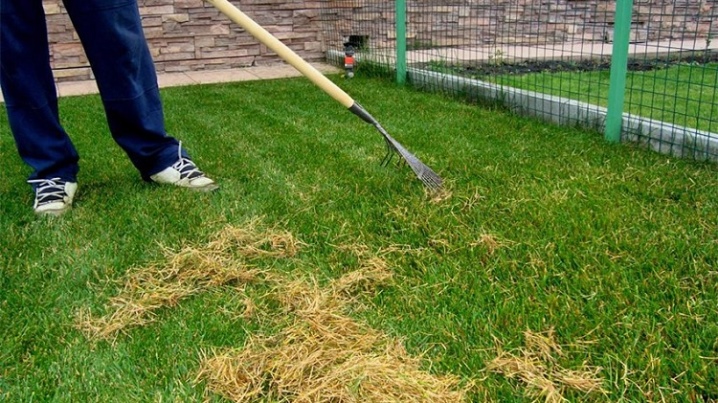
Spring processing:
- dry yellow grass is mowed and harvested;
- loosen the soil;
- sow new seeds to the damaged area and to the entire area;
- mulch with a composition of sand and peat with a layer of 0.5-1 cm;
- well watered.
In summer, in dry weather under the hot sun, the green cover can lose its attractive appearance, sometimes even abundant watering does not help. It is better to start recovery long before the onset of cold snaps - at the beginning of autumn. September is the perfect time.
Autumn processing:
- in damaged spaces, plants are removed by the root;
- the soil is dug up, adding fertile mixtures, nitrogen fertilizers, acidic soil is watered with lime or dolomite;
- well loosened;
- the rest of the grass is mowed to a height of 2.5-4 cm;
- mix seeds with soil mixture in a 1: 2 ratio;
- fill in prepared areas;
- leveled and mulched with peat, sand to a layer of 1 cm;
- planting sites are watered.
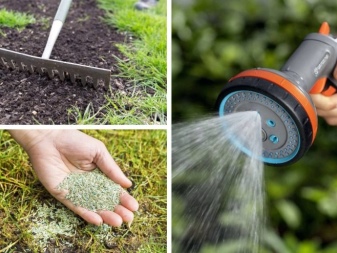

The seeds for development and growth should have about a month before the onset of frost. The shoots are cut down for the winter, like the entire lawn.
You can also overseed in winter, for example, in November, when the ground is slightly frozen. The stems are cut, leaving about 5 cm. A day with a positive temperature is chosen, the seeds are scattered over the surface and sprinkled with peat. Spring shoots will be more resistant to diseases, excess moisture and sun will give the shoots an additional stimulus.
When choosing a mixture for planting, take into account:
- composition and ratio of different varieties in the set;
- germination and growth rate;
- exactingness of different types to lighting, moisture, temperature;
- decorative qualities.
It is believed that the same planting mix that was purchased before would be the ideal choice. You can also plant the existing composition of the grass mixture. The grown grass will not stand out against the general background, but it does not grow so quickly, and in a specific area it may turn out to be unstable, so replanting will be required. To repair the lawn, special repair kits are sold, which include fast-growing varieties. In appearance - color intensity, stem thickness, leaf width - there can be noticeable differences between previous and planted plants.
But if you sow new ones evenly over the entire area, the grass cover will look uniform.
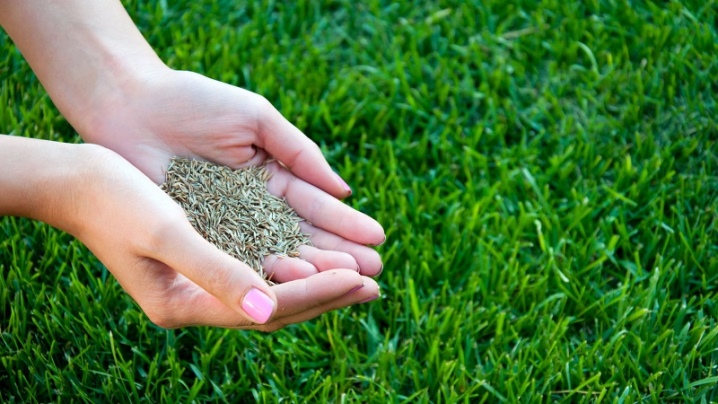
It is worth considering the following point: if the territory is in the shade for a significant part of the day, then it is better to plant shade-tolerant varieties. When planting over the entire area, it is recommended to sow seeds crosswise: half of the seeds along, and the other - across.
For an instant restoration of the decorative appearance of the lawn, a rolled lawn will be an excellent solution. This is a ready-made green carpet grown on a specially prepared material. When choosing a ready-made sod with a green cover, they take into account how the lawn grass looks in color and texture on the site itself. If there are few empty spaces, a piece of turf can be cut from the edge of your own field.
The way to lay the finished layers:
- dig up empty bald spots;
- make peat, organic and mineral fertilizing;
- cut out a flap of the desired shape or a slightly larger size;
- laid and tamped (sometimes a press is used);
- the gaps in the joints, if any, are sprinkled with earth;
- watered regularly.
The indisputable advantage of this method of repair is obvious - in one day the area around the house will be transformed, the restored lawn will look fresh and natural.
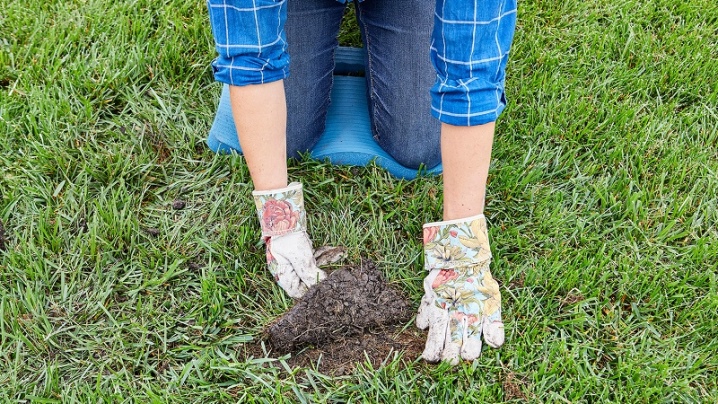
Follow-up care
After renovating the lawn, the entire area needs to be looked after, and new plants may require additional care. What you need to do so that the seedlings appear quickly and do not wither:
- they do not go to the repaired places until the seedlings have taken root and have not grown stronger;
- it is necessary to water the lawn abundantly (about a month) until the shoots take root;
- avoid waterlogging, and after rooting, reduce watering by 2 times;
- after rain and watering, do not move around the lawn so that the soil does not sink and lowlands do not appear;
- in case of frequent rains or cold snaps, the shoots must be covered with burlap or geotextiles;
- the grass is mowed when the stems become about 10 cm in height;
- it is necessary to remove dead parts with a rake;
- feeding is done 2-3 times per season: in spring - with nitrogen, in summer - with complex fertilizers, in autumn - with phosphorus, potassium;
- for the winter, the entire surface is sprinkled with a layer of fertile soil.
Live shoots cannot tolerate synthetic materials, so you should not leave garbage here, refuel the mower and the car. Regular mowing makes the lawn tidy and creates a dense carpet. When mowing the stems, they leave at least 3-4 cm from the root. Then they give the opportunity to update, and another time they cut it only at a height of 13-15 cm.
It is recommended to sow the old lawn regularly, because the green carpet gradually begins to thin out, and weeds take up free space. Young growth helps to protect the soil from weeds. For optimal grass cover, plant about 25-30 g of seeds per m2, then a green carpet around the house or in recreation areas will delight the eye every day.
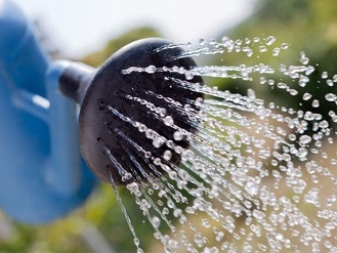
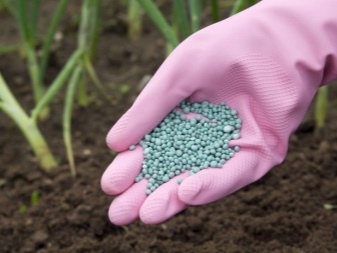
The next video will tell you about the spring sowing of the lawn.



































































The comment was sent successfully.